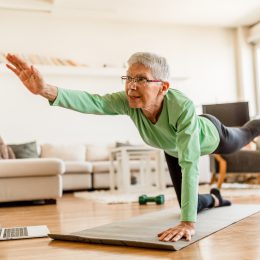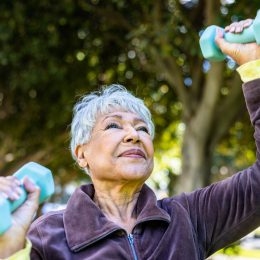Fix Your Posture: A 4-Step Plan
Standing taller doesn’t just make you look and feel better. It makes you healthier too.

Posture is about so much more than sitting up straight. It’s a reflection of your overall health.
“With good posture, we place the least amount of strain on our muscles, bones, and ligaments as we move, walk, sit, and lie down,” explains Stacey Pierce-Talsma, D.O., chair of osteopathic manipulative medicine at Touro University California. Our bodies—down to our organs—function naturally and efficiently, and no energy goes wasted.
As soon as your posture starts to break, things go awry. “We add tension and compression to structures that weren’t meant to bear that weight,” Dr. Pierce-Talsma says. “This wears down our bones, joints, and ligaments, and even changes the way our muscles fire or work.”
The result: fatigue, pulled muscles, disc degeneration, and pinched nerves. In addition, hyperkyphosis (commonly referred to as a “hunched” back) can impair respiratory functions and throw off balance to increase the risk of falls, she says.
Follow this simple four-step guide to getting your posture—and your total health—back on track.
Step 1: Determine What Good Posture Looks (and Feels) Like for You
Find a floor-length mirror, and turn sideways. Stand as you normally do, and take a peek. This will likely be less-than-stellar posture. Now, engage your upper back to bring your shoulders back and down, says Nicholas M. Licameli, D.P.T., a physical therapist at Professional Physical Therapy. Your chest should now be a bit higher, but be careful not to puff it out to the point that your upper back rounds. Pull your chin back so that your neck and upper back are as vertical as possible.
Next, turn your attention to your ribs. Do they point straight down, or do they flare out at the bottom? Try shifting your rear (you may need to tuck it in or stick it out a bit) until your ribs point straight down over your hipbones. Once you find this alignment, squeeze your core muscles to tighten your midsection, and hold that position. That’s your perfect posture. While this exercise helps you find it while standing still, it’s the same spinal posture you should maintain when walking, lifting weights, or sitting at the dinner table.
It may feel like a bit of work at first, but it shouldn’t feel uncomfortable. And as you follow these next steps, it’ll become second nature.
If you use a wheelchair or have a spine condition like scoliosis, talk to your doctor about what good posture looks like for you. What is right for someone else may not look exactly right for you, but many of the principles of good posture still apply. Proper positioning in a wheelchair can help you breathe better and avoid strain in your upper body, and strengthening the body can help your posture if you have scoliosis.
Step 2: Notice When You Break Your Posture
Once you know good posture, it becomes easier to pinpoint when it starts to break down. “I tell my patients to let pain be their reminder,” says Brad Allison, D.P.T., an orthopedic specialist at Midwest Orthopaedics at Rush in Munster, Indiana. “If you have neck or mid-back pain, that’s a sign to correct your posture.”
Your posture is most likely to break down when sitting or using gadgets like phones or tablets. No matter the activity, it’s important to keep your ribs over your hips, shoulders pulled back, and—this can be a tough one with electronics—your face pointed forward.
“Try to keep things at eye level,” says Dr. Pierce-Talsma, noting that looking down at whatever’s in your hand or on your lap puts a huge amount of tension on your neck. While the average human head weighs about 10 to 12 pounds, if you tilt yours forward to look down at your phone, you put up to 60 pounds of pressure on your neck, according to research in Surgical Technology International.
Step 3: Don’t Sit for Longer than 30 Minutes at a Time (If You Can Help It)
The more active you can be, the better. Activity keeps the muscles that stabilize your spine as strong as possible and prevents muscles in your hips from getting tight, which can throw off your alignment. While exercise definitely plays a part in staying active (we’ll get to that next), it’s also important to reduce the amount of time you sit each day. Research from Northwestern University shows that women who exercise regularly sit just as much as their less-active counterparts. That’s bad news.
Subscribe to our newsletter
It's quick and easy. You could be one of the 13 million people who are eligible.
Already a member? Click to discover our 15,000+ participating locations.
Follow Us
When you do find yourself sitting, make it a priority to take frequent mobility breaks. “For each 30 minutes spent sitting, try to stand up at least once,” Licameli says. “If you’re watching television, stand during commercials.” The important part isn’t just standing. It’s standing with correct posture and, ideally, engaging in some light activity such as walking or even foam rolling your back, glutes, and hamstrings. Do whatever helps you reset, ease any tight muscles, and maintain a strong posture.
Step 4: Strengthen Your Core
Fixing your posture ultimately requires more than awareness and practice. Your spine doesn’t act on its own. Dozens of muscles that surround and connect your spine, pelvis, ribs, and shoulders are in control. To do their jobs correctly, they need to be strong, Allison says.
That’s where a balanced strength-training program, with an emphasis on your core, comes in. It’s important to realize that your core is more than your abs. It’s actually your entire torso, including your chest, abdomen, back, and even glutes—all of those muscles that are in charge of your posture, Allison says. To strengthen them all, make sure to include a range of:
- Pulling and pushing movements: seated rows, lat pulldowns, wall pushups, rotary chest presses
- Hip-hinging exercises: hip hinges, hip extensions, squats
- Torso stability exercises: bird dogs, dead bugs
Learn more in this beginner’s guide to strength training for older adults. And remember, what’s right for someone else may not be exactly right for you. Try a smart tweak to make an exercise easier so you can maintain good form, or talk to your doctor if you have a spine condition or injury, or use a wheelchair.
Take Your Favorite SilverSneakers Classes Online!
SilverSneakers members can access live fitness classes and wellness workshops through SilverSneakers LIVE. See the latest schedule and RSVP for classes here.
Not a member? If you have a Medicare Plan, it may include SilverSneakers—at no additional cost. Check your eligibility instantly here.




